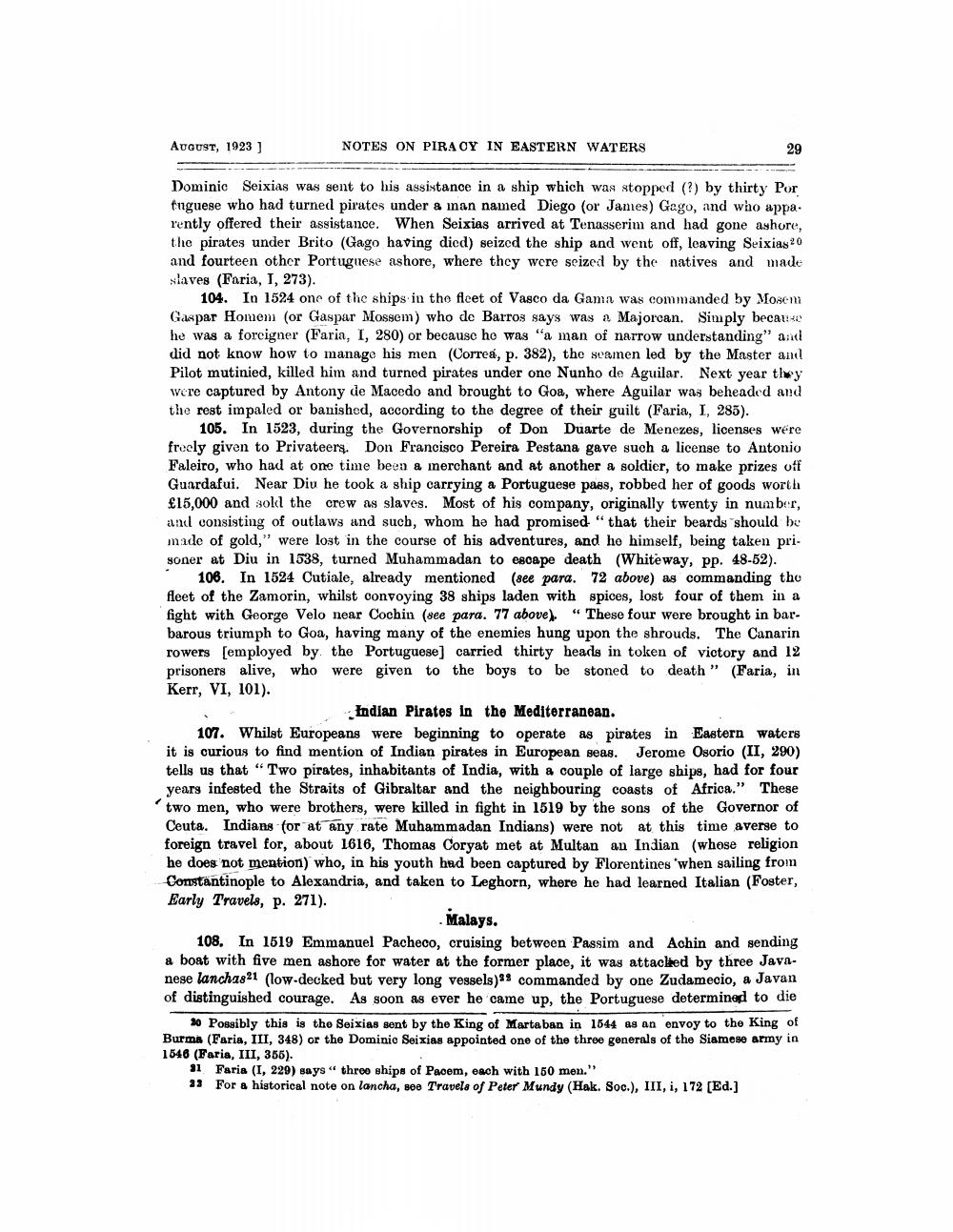________________
AUGUST, 1923 ]
Dominic Seixias was sent to his assistance in a ship which was stopped (?) by thirty Por tuguese who had turned pirates under a man named Diego (or James) Gago, and who appa rently offered their assistance. When Seixias arrived at Tenasserim and had gone ashore, the pirates under Brito (Gago having died) seized the ship and went off, leaving Seixias 20 and fourteen other Portuguese ashore, where they were seized by the natives and made slaves (Faria, I, 273).
NOTES ON PIRACY IN EASTERN WATERS
29
104. In 1524 one of the ships in the fleet of Vasco da Gama was commanded by Mosem Gaspar Homem (or Gaspar Mossem) who de Barros says was a Majorcan. Simply because he was a foreigner (Faria, I, 280) or because he was "a man of narrow understanding" and did not know how to manage his men (Correa, p. 382), the seamen led by the Master and Pilot mutinied, killed him and turned pirates under one Nunho de Aguilar. Next year they were captured by Antony de Macedo and brought to Goa, where Aguilar was beheaded and the rest impaled or banished, according to the degree of their guilt (Faria, I, 285).
105. In 1523, during the Governorship of Don Duarte de Menezes, licenses were freely given to Privateers. Don Francisco Pereira Pestana gave such a license to Antonio Faleiro, who had at one time been a merchant and at another a soldier, to make prizes off Guardafui. Near Diu he took a ship carrying a Portuguese pass, robbed her of goods worth £15,000 and sold the crew as slaves. Most of his company, originally twenty in number, and consisting of outlaws and such, whom he had promised "that their beards should be made of gold," were lost in the course of his adventures, and he himself, being taken prisoner at Diu in 1538, turned Muhammadan to escape death (Whiteway, pp. 48-52). 106. In 1524 Cutiale, already mentioned (see para. 72 above) as commanding the fleet of the Zamorin, whilst convoying 38 ships laden with spices, lost four of them in a fight with George Velo near Cochin (see para. 77 above), "These four were brought in barbarous triumph to Goa, having many of the enemies hung upon the shrouds. The Canarin rowers [employed by the Portuguese] carried thirty heads in token of victory and 12 prisoners alive, who were given to the boys to be stoned to death" (Faria, in Kerr, VI, 101).
Indian Pirates in the Mediterranean.
107. Whilst Europeans were beginning to operate as pirates in Eastern waters it is curious to find mention of Indian pirates in European seas. Jerome Osorio (II, 290) tells us that "Two pirates, inhabitants of India, with a couple of large ships, had for four years infested the Straits of Gibraltar and the neighbouring coasts of Africa." These two men, who were brothers, were killed in fight in 1519 by the sons of the Governor of Ceuta. Indians (or at any rate Muhammadan Indians) were not at this time averse to foreign travel for, about 1616, Thomas Coryat met at Multan an Indian (whose religion he does not mention) who, in his youth had been captured by Florentines 'when sailing from Constantinople to Alexandria, and taken to Leghorn, where he had learned Italian (Foster, Early Travels, p. 271).
Malays.
108. In 1519 Emmanuel Pacheco, cruising between Passim and Achin and sending a boat with five men ashore for water at the former place, it was attacked by three Javanese lanchas21 (low-decked but very long vessels) commanded by one Zudamecio, a Javan of distinguished courage. As soon as ever he came up, the Portuguese determined to die
20 Possibly this is the Seixias sent by the King of Martaban in 1544 as an envoy to the King of Burma (Faria, III, 348) or the Dominic Seixias appointed one of the three generals of the Siamese army in 1546 (Faria, III, 355).
31 Faria (I, 229) says" three ships of Pacem, each with 150 men."
33 For a historical note on lancha, see Travels of Peter Mundy (Hak. Soc.), III, i, 172 [Ed.]




